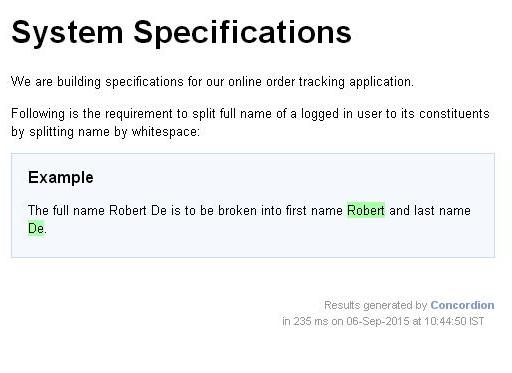Concordion – 返回地图
Concordion – 返回地图
Concordion execute 命令可用于以 Map 的形式获取行为的结果,使用它我们可以获得一个行为的多个输出。例如,考虑以下要求 –
The full name Robert De is to be broken into its first name Robert and last name De.
这里我们需要有一个溢出函数,它接受一个用户名并返回一个 Map 对象,该对象以 firstName 和 lastName 作为其具有相应值的键,以便我们可以使用它们。
如果我们想为这样的拆分函数编写一个规范,它将接受一个用户名并输出一个结果对象,那么以下将是规范 –
<p>The full name <span concordion:execute = "#result = split(#TEXT)">Robert De</span> is to be broken into first name <span concordion:assertEquals = "#result.firstName">Robert</span> and last name <span concordion:assertEquals = "#result.lastName">De</span>.</p>
Concordion 在解析文档时,会将特殊变量#TEXT 的值设置为当前元素的值作为“Robert De”,并将其传递给 split 函数。然后它将使用 execute 命令以参数为 #TEXT 执行 split() 方法,并将结果设置到 #result 变量中,并使用结果映射,打印 firstName 和 lastName 值作为输出。
例子
让我们有一个可用的 Eclipse IDE,并按照下面给出的步骤创建一个 Concordion 应用程序 –
| Step | 描述 |
|---|---|
| 1 | 创建一个名为concordion的项目,并在创建的项目的src文件夹下创建一个包com.tutorialspoint。 |
| 2 | 使用添加外部 JAR选项添加所需的 Concordion 库,如Concordion – First Application章节中所述。 |
| 3 | 在com.tutorialspoint包下创建 Java 类System。 |
| 4 | 创建夹具类SystemFixture下specs.tutorialspoint包。 |
| 5 | 建立规范的HTML System.html下specs.tutorialspoint包。 |
| 6 | 最后一步是创建所有 Java 文件和规范文件的内容并运行应用程序,如下所述。 |
这是 System.java 文件的内容 –
package com.tutorialspoint;
import java.util.HashMap;
import java.util.Map;
public class System {
public Map split(String userName){
Map<String, String> result = new HashMap<String, String>();
String[] words = userName.split(" ");
result.put("firstName", words[0]);
result.put("lastName", words[1]);
return result;
}
}
以下是 SystemFixture.java 文件的内容 –
package specs.tutorialspoint;
import java.util.Map;
import com.tutorialspoint.Result;
import com.tutorialspoint.System;
import org.concordion.integration.junit4.ConcordionRunner;
import org.junit.runner.RunWith;
@RunWith(ConcordionRunner.class)
public class SystemFixture {
System system = new System();
public Map<String, String> split(String userName){
return system.split(userName);
}
}
以下是 System.html 文件的内容 –
<html xmlns:concordion = "http://www.concordion.org/2007/concordion">
<head>
<link href = "../concordion.css" rel = "stylesheet" type = "text/css" />
</head>
<body>
<h1>System Specifications</h1>
<p>We are building specifications for our online order tracking application.</p>
<p>Following is the requirement to split full name of a logged in user to its
constituents by splitting name by whitespace:</p>
<div class = "example">
<h3>Example</h3>
<p>The full name <span concordion:execute = "#result = split(#TEXT)">Robert
De</span> is to be broken into first name <span
concordion:assertEquals = "#result.firstName">Robert</span> and last name
<span concordion:assertEquals = "#result.lastName">De</span>.</p>
</div>
</body>
</html>
完成源文件和规范文件的创建后,让我们将应用程序作为 JUnit 测试运行。如果您的应用程序一切正常,那么它将产生以下结果 –
C:\DOCUME~1\ADMINI~1\LOCALS~1\Temp\concordion\specs\tutorialspoint\System.html Successes: 1, Failures: 0
System.html 是 Concordion 测试运行的输出。

